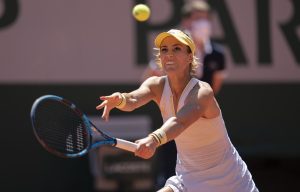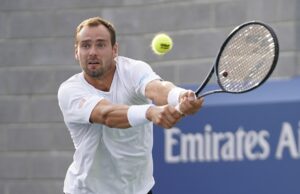Tennis fans are still eagerly awaiting the return of the sport after the suspension of the season due to the coronavirus pandemic. But with that return now on the horizon, what better time is there to look back at some of the great matches of yesteryear. The 2000’s saw some particularly thrilling women’s finals at the Grand Slams and Last Word on Tennis has picked out the five best women’s Grand Slam finals of the 2000s.
The Five Best Women’s Grand Slam Finals of the 2000’s
Jennifer Capriati beat Kim Clijsters 1–6 6–4 12–10 – French Open 2001
Jennifer Capriati came into the second Major of 2001 as the fourth seed, having won her first Grand Slam five months earlier at the Australian Open, beating Martina Hingis in straight-sets in the final. She breezed through the early rounds in Paris to set up a quarterfinal-clash with Serena Williams. It proved to be a close contest, but Capriati edged out her compatriot in three before scoring another decisive win over Hingis to reach her first final at Roland Garros.
Kim Clijsters, meanwhile, had never been past the quarterfinals at a Major, but was seeded 12th and looked to have a bright future ahead of her. She raced through the first week, before beating Slovakia’s Henrieta Nagyová to reach the quarterfinals. There she hammered the qualifier Petra Mandula to reach her first Grand Slam semifinal, where she recovered from a set down to beat her countrywoman Justine Henin 6-3 in the decider.
Embed from Getty Images
The final came a day after Clijsters’ 18th birthday and she made a superb start, storming to the first set for the loss of just one game. But the more experienced Capriati dug in to level the match, winning the second set 6-4. That set up a tense third set, in which neither woman could gain a decisive advantage. But in the end, despite hitting 79 unforced errors and squandering two match points, it was Capriati who lasted the distance. She broke in the 21st game of the set, before serving it out to claim her first French Open title.
It capped a remarkable return for Capriati, who had reached the semifinals in Paris 11 years earlier as a teenager, only to prove unable to deal with the relentless media attention, which included an appearance on the cover of Sports Illustrated aged just 13. That had led to a disastrous burnout which saw her play just one match between 1994 and 1996. But she put those memories firmly to bed on a glorious day at Roland Garros.
Jennifer Capriati beat Martina Hingis 4–6 7–6 (9–7) 6–2 – Australian Open 2002
Arriving at the 2002 Australian Open as defending champion and world #1, Capriati was widely expected to defend her title in Melbourne. Hingis had won a hat-trick of a titles in Australian between 1997 and 1999, but had seen her run stopped by Lindsay Davenport in 2000 in the final before falling at the final hurdle again a year later – to none other than Capriati. That left her seeking revenge as she battled into her sixth consecutive final at Melbourne Park.
She certainly looked in good enough form to claim the title. The Swiss lost just 13 games in reaching the semifinals, where she rallied from a set down to beat Monica Seles 4-6 6-1 6-4. Capriati, meanwhile, advanced to the quarterfinals comfortably enough and scored a statement win in the last eight, dispatching Amelie Mauresmo 6-2 6-2. That set up a semifinal meeting with Clijsters with Capriati finishing strongly to claim a 7-5 3-6 6-1 win.
Embed from Getty Images
But in the final, the world #1 found herself on the backfoot almost immediately. Hingis came out swinging and stormed out to a 5-1 lead. Belatedly, Capriati fought back, but she could not stop Hingis from taking the first set by six games to four. And the Swiss looked to have the match won when she broke Capriati twice to take a commanding 4-0 lead in the second set. Capriati, however, had no intention of going quietly into the night.
The American saved three championship points to force a tiebreak, where she saved another championship point before winning 9-7. Hingis somehow recovered from that disappointment to break first in the decider, but her challenge faded thereafter. Capriati broke straight back before reeling off the next four games to complete an extraordinary fightback and win her third and final Grand Slam title.
Serena Williams beat Venus Williams 7–5 6–3 – French Open 2002
Serena Williams began her professional career in 1995 and by 2002 she had established herself as a top-five player and Grand Slam champion, having won the US Open in 1999. But she remained somewhat in the shadow of her older sister Venus, who had already claimed four Majors, with back-to-back triumphs at both Wimbledon and the US Open in 2000 and 2001. She had dismissed Serena for the loss of only six games in the final in New York in 2001.
Embed from Getty Images
But Serena, seeded third in Paris, looked sharp in the early rounds. She reached the semifinals for the loss of just one set. There, despite losing the first set, she ousted the defending champion Capriati. However, Venus’ form in reaching the final was more impressive still. Indeed, the elder Williams reached the title-match without dropping a set, scoring a dominant 6-1 6-4 win over Argentina’s Clarisa Fernandez in the semifinals.
In their second Grand Slam final, there was little between them in a tight opening set. But Serena broke late to win it, before sealing a 7-5 6-3 win in the second. It began a period of dominance for Serena, who went on to dethrone her sister at Wimbledon and the US Open, beating Venus in straight-sets in both finals. She then beat Venus again in the final at the Australian Open in 2003, completing the ‘Serena Slam’, making her the fifth woman to hold all four Slams.
Maria Sharapova beat Serena Williams 6-1 6-4 – Wimbledon 2004
Russia’s Maria Sharapova was just 17 when she found herself in her first Wimbledon final. She had turned professional only two years earlier and had made her debut at the All England Club a year earlier, reaching the fourth round. Williams, in contrast, had won five of the last seven Grand Slams she had entered and was the defending champion at Wimbledon, having won back-to-back titles in SW19 in 2002 and 2003.
Sharapova, seeded 13th, had eased into the quarterfinals without dropping a set, before beating Ai Sugiyama from a set down to make the semifinals, where Davenport awaited her. She again dropped the first set, but came back to win in three. Williams, meanwhile, was in similarly dominant form. The American reached the semifinals without dropping a set, thrashing Capriati for the loss of just two games in the last eight.
Embed from Getty ImagesBut in the last four, she was brought to the brink by the fourth-seeded Mauresmo. The Frenchwoman won the first set in a tiebreak, but Williams battled back to win the second 7-5 and then sealed her place in a third consecutive Wimbledon final by winning the third 6-4. But that lengthy semifinal battle looked to have left Williams short of energy and focus in the opening exchanges of the final. Sharapova took the first set at a canter, losing just one game, as a stunned Centre Court crowd watched on.
Williams sought to fight back in the second set, even as Sharapova remained in the ascendancy. In the ninth game of the second set, Williams defiantly saved three break points to stay in contention. But Sharapova forced a fourth and Williams finally bowed under the pressure. The 17-year-old Sharapova then fearlessly served out the win to claim a remarkable victory, becoming the third youngest champion at Wimbledon in the process.
Venus Williams beat Lindsay Davenport 4–6 7–6 (7–4) 9–7 – Wimbledon 2005
A year later at Wimbledon, Venus Williams returned to a Grand Slam final for the first time since the 2003 Championships. Davenport awaited her. Davenport held the #1 ranking, but she had not contested a Major final since losing to Venus at the US Open in 2000, having suffered the same fate at Wimbledon earlier that summer. But she had looked in good form in working her way through the early rounds at the All England Club.
She faced her first real test up against Kim Clijsters in the fourth round, but defeated the Belgian in three sets before beating the fifth seed Svetlana Kuznetsova in the quarterfinals in straight-sets. She then reached the final after a titanic tussle with Mauresmo, with Davenport emerging a 6-7 7-6 6-4 winner as the Frenchwoman was denied in the semifinals for the second year in a row.
Embed from Getty Images
Williams, seeded 14th, progressed serenely to the quarterfinals. There, after winning the first set to love, she was taken to a tiebreak, eventually claiming it 12 points to 10. That set up a semifinal clash with defending champion Sharapova. But unlike Serena a year earlier, Venus was not troubled by the Russian, claiming a comfortable 7-6 6-1 win over the second seed as she reached the final without having dropped a set.
That perfect record was broken by Davenport, who took the first set of the final 6-4. The world #1 then broke late in the second set to give her the chance to serve for the title. But Williams battled back, firing three winners as she broke to love before levelling the match in a tiebreak. Davenport, however, refused to surrender despite that disappointment. In an enthralling final set, she earned a match point when Williams double-faulted.
But Venus saved it with a powerful backhand winner and that, at last, seemed to break Davenport’s resolve. She dug in to hold serve and eventually sealed a 9-7 win after two hours and 45 minutes, in what was the longest women’s singles final in Wimbledon history.
Main photo:
Embed from Getty Images






